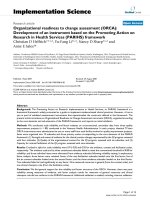Lecture Conducting and reading research in health and human performance (4/e): Chapter 10 - Ted A. Baumgartner, Larry D. Hensley
Bạn đang xem bản rút gọn của tài liệu. Xem và tải ngay bản đầy đủ của tài liệu tại đây (212.71 KB, 16 trang )
Chapter 10
Qualitative Methods in Health
and Human Performance
Qualitative Methods
Qualitative research is an umbrella concept
covering several forms of inquiry that focus
on understanding and explain meaning of a
social phenomena
Data Collection Methods
Quantitative
–
–
–
–
–
Objective
Numeric
Statistical analysis
Large Ns
Structured data
collection
– Table/graphs to display
results
Qualitative
–
–
–
–
–
Subjective
Nonnumerical
Nonstatistical analysis
Small Ns
Open ended data
collection
– Narrative for results
Qualitative Methods
Eight characteristics of qualitative research
– Takes place in the natural setting: travel to sites
– Researcher is the primary method of data
collection
» Observation
» Interview
» Documents
» Audiovisual
Qualitative Methods
Characteristic continued:
– Emergent rather than tightly prefigured
– Based upon interpretation
» Hermeneutics: deciphering meaning
– Views social phenomena holistically
– Qualitative researchers reflect and are explicitly
regarding personal assumptions and values
Qualitative Methods
Characteristics continued
– Uses both deductive and inductive logic
» Inductive: going from specific to large
» Deductive: Going from broad to specific
– Can use multiple methods
Qualitative Methods
Grounded Theory Study
– Discover or invent theory grounded in real
world experiences
» Middlerange theories: situation related
Life histories
– Story of a single individual or groups of single
individuals
» Recall significant events of ones life
» Significant understanding of the historical context
Qualitative Methods
Case Study
– Exploration of a bounded system (e.g., school)
– Indepth data collection involving multiple
sources of information
Phenomenology study
– Describes the meaning of a lived experience for
several individuals about a phenomenon
– Explores the structures of human consciousness
Qualitative methods
Ethnography study
– Interpretation of a culture of social group
– Natural setting
Basic/Generic
– Studies that illustrate characteristics of
qualitative research
Accurate Interpretations?
Verification: Interpretations are tested for
plausibility, conformability and
trustworthiness (7 strategies)
– Prolonged engagement: Learning culture and
building trust by being in a culture for a long
time
– Triangulation: use different methods for
corroborating evidence
Accurate Interpretations?
Verification continued
–
–
–
Peer review: group of peers review work
Clarification of research biases and values
Member checks: research participants check
credibility of interpretations and data
– Rich description statements: Provide evidence
by detail in write up – are findings transferable?
– External audit: External person(s) examine
process and interpretations
Multiple Methods
“Rather than taking sides on this recurring
issue, we suggest that multimethods
approaches can provide a more accurate and
detailed research project than the traditional
unidimensional (qualitative or quantitative)
approaches provide”
Mitra & Lankford, 1999, p. 46
Interviews
Closed quantitative: Questions and response categories are
determined in advance; responses are fixed
Standardized openended: The wording and sequence of
questions are determined in advance; same basic questions
in the same order
Interview guide: Topics and issues to be covered are
specified in advance, however, the interviewer decides the
sequence and wording of questions during the interview
Informal conversational: Questions emerge from the
immediate context and are asked in the natural course
Observations
Complete Participation: Researcher
conceals role
Observer as Participant: Role of researcher
is known
Participant as Observer: Observational role
is secondary to participant role
Complete Observer: Researcher observes
without participating
Constant Comparison
A technique for analyzing qualitative data
– Read through data (transcriptions of interviews)
and find similar (constant) themes among
people
Gain perspectives relevant to the context in
which the data was observed and recorded
Steps in a Constant Comparison
Read through interviews separately (among many)
and make code/theme notes
After reading through the differing transcriptions,
integrate and compare codes/themes
Delimit and refine the themes to find major or
primary themes (can have secondary themes)
Provide examples from the data that highlight the
themes









